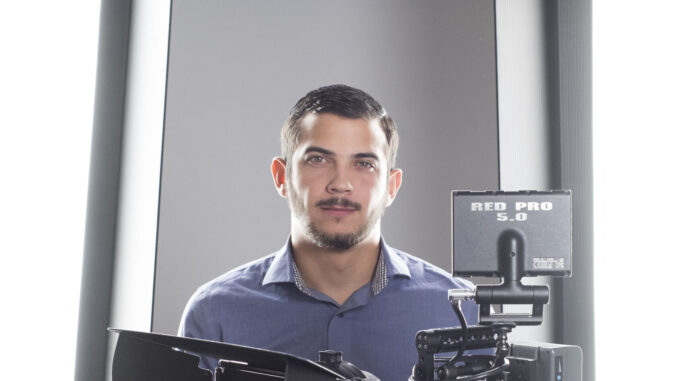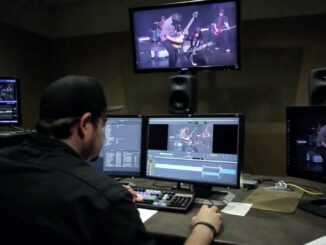
By Katie Grant
“If I wanted more stories to exist, I was going to have to make them.”
That is what Toj Mora says he understood as a young student, when he realized that there weren’t many movies devoted to Deaf viewers.
At the Texas School for the Deaf, Mora, Deaf since birth, took a video tech class. “Within a semester I had exhausted the school’s small collection of Deaf films and I remember thinking to myself, ‘That’s all?,'” he said.
Mora’s passion for Deaf stories, mixed with his love for solving puzzles, and a dash of ADHD (attention deficit hyperactivity disorder), led to editing as a natural career fit. “It’s just like the ultimate video game. It’s putting the puzzle pieces together with the best of what you have. You have to find a way to make it work. So that creative process has always been an enjoyable challenge for me.”
Picture editing might not seem like the most natural choice for someone with hearing issues, given the intricate ties between picture and sound in filmmaking. But Mora and others are expanding the possibilities in the field.
Emmy-Nominated James Cude, ACE, a Hard-of-Hearing editor and Guild member, has progressive sensorineural hearing loss and his own set of challenges. He considers ASL his second language. “I have to straddle both worlds,” he said. “I have to behave like a hearing editor because a lot of my work is with sound. People have a misconception about what Deafness is and are afraid to ask about it. Don’t assume that I can or cannot do something. Ask and I’ll tell you.”
Cude says waveforms have been a game changer for Deaf editors. “I learned how to do waveforms on a timeline. You can edit your audio by looking at a waveform and recognizing certain sounds. I’ll clip the S’s and T’s a lot because I can’t hear them, but you learn how to see what they look like visually and how to cut that.
“You learn to rely on other forms of communication,” he added. “It’s not just audio. You learn to be more perceptive in terms of what you’re looking for and at. They call it the ‘deaf eye.’ You pick up on things visually very quickly. I work in documentaries mostly, and I work with transcripts a lot. I can read a transcript and cut a scene very quickly. It surprises me that hearing editors don’t do that. All the editing softwares now have transcriptions built into them, so there’s literally no reason not to do it anymore.”
Often, hearing filmmakers will shape Deaf stories with a style of filming sometimes called “the hearing gaze.” Close-ups of the faces of Deaf characters and hands signing in slow motion are classic examples of the phenomenon, which is an adaptation of “the male gaze” coined by filmmaker Laura Mulvey in 1970. Mulvey’s theory focused on the problematic portrayals of the female body in film and television, Mora says that the industry is only just beginning to explore authentic representation of Deaf people.
The Hearing Gaze fetishizes, or objectifies, the elements of ASL and Deafness that appeal most to hearing viewers. Poor framing is also part of the hearing gaze at play. While signs are often cut off by the framing of the shot during production, in Mora’s experience, even if there are wider alts, hearing editors and directors often choose closer shots because they prefer to see the actor’s faces – the signs are an afterthought.
“To cut ASL correctly, you need a Deaf editor,” Mora said. “Not a hearing person who knows ASL from high school. Not an interpreter. Not a linguistic consultant. You need a Deaf editor. There are a lot of nuances that come with editing sign language.”
Deaf sound work is another example of the “hearing gaze.” “Scenes with Deaf people can include a lot of breathing and body touching, which create sound,” Mora said. “And, oftentimes, that audio is featured in the sound design ‘in lieu’ of dialogue. Sometimes editors and directors can get lost in the distraction of that hearing gaze instead of focusing on the subject. The Deaf person is the subject, not what they’re doing.”
Mora argues that most issues needing fixing in ASL are pre-production related, such as not budgeting up front for interpreters, or missing things during production, like not shooting open gate. In those cases, he’s been grateful to be brought in for damage control.
The final hurdle is then the physical logistics of having a Deaf editor stand behind the hearing editor looking over their shoulder at the screen while they are driving the Avid. Trying to relay feedback from ASL to spoken English is not exactly accessible or quick in that scenario.
When Mora notices a change is needed, he signs, “Wait, go back,” to the interpreter who then says, “Okay, go back,” to the hearing editor. By the time they do, it’s so far past the desired spot that precious time is wasted. At times, Mora will ask if he can take control to quickly reveal the issue. Some editors will relinquish control, but he says he is always respectful when they don’t.
Mora’s respect for Deaf filmmakers started with one of his mentors, Deaf filmmaker, editor, and TEDx speaker Wayne Betts Jr (“Gallaudet: The Film,” “Glee!,” “The Deaf Family”). He introduced Mora to the concept of the “Deaf Lens,” which could be described as “trying to conceptualize what the deaf perception is and how that is portrayed visually through filming and editing.” Betts proposes an entirely new way of filming Deaf/ASL footage so that the viewer gets a sense of how a Deaf person experiences the world. And that made a big impact on Mora, expanding his mind and helping him to understand what editing is and to think like an editor.
“Sign language, in my opinion, is the most unforgiving language to edit,” said Mora. “There is no ADR for sign language. There’s no fixing it in post. And, if there was, I’d be surprised if there was a budget for it.”
Technically speaking, there are a few things Mora suggests hearing editors use to make editing ASL easier. The first is to always have the production shoot “open gate.” Open gate, or Full Sensor Recording, is when the entire image is filmed without any cropping or matting for specific aspect ratios. Then the aspect ratio matting is applied at a later stage. This is important when cutting ASL to ensure that all the signing remains in the shot when necessary while also allowing other changes to easily be made.
“Don’t get me wrong,” Mora said, “Deaf filmmakers still use close-ups. We use every kind of frame and shot. The only difference is we know when to use a close-up versus when not to use a close-up.”
Captions are another essential element often overlooked by productions. Mora suggests using captions before, during, and after editing so you can see what part of the shot might be cut off when the show is screened. It’s also possible to have temp captions on the video village monitor during production to see what part of the shot might be covered up or if any colors in the shot might blend into the captions making them irrelevant.
In a perfect world, the dailies would have captions as well. Mora suggested, “I would prefer that the team send it to the captioning house and let them manage that. And I would prefer it to be a Deaf-owned caption house, such as Caption Anywhere.”
Mora treats captions as sound files. He keeps them with a clip so that it moves together all the time. He admits Avid is sometimes a bit lacking about managing caption files. But that’s even more reason to push for innovation in that space. “Adobe is killing it. Avid needs to wake up and catch up.”
In response, Matt Feury, Sr. Director of Market Solutions for Video and Postproduction at Avid, said: “Avid has actually been paying quite a bit of attention to captioning and speech-to-text workflows this year. In our latest release of Media Composer we introduced the Transcript Tool, an AI-enhanced extension of our PhraseFind technology that displays automated transcripts of source clips, including speaker identification and timecode. The transcript is ganged to the source window so that the transcript not only stays in sync with the playback of the clip, but can also be used to mark the clip for editing simply by selecting the desired text in the window. In addition to the Transcript Tool, there are some other exciting things we’re doing for captioning that will make their debut at the IBC trade show in a few weeks.”
Beyond captioning, another important facet of editing Deaf footage is “ASL continuity”. That’s a term Mora invented a few years back, but it’s the same concept as any continuity. If an editor doesn’t know ASL well, they can’t know exactly how, what or when to cut that is acceptable, distracting, overlooked or missing. So, cutting from one shot to another with continuous ASL can be difficult to truly understand without the cultural nuance. That includes everything from the speed of the sign to the placement of a sign. From the expression accompanying a sign to the body position and eye position. Even if a person is in the middle of a breath or not during the production of a sign can make a difference.
Mora recently lost a Deaf colleague, Michael Epstein, who was an IATSE member in the Art Director’s Guild. He recalls their last conversation about how to bolster equal representation in Hollywood, “He told me there are many Deaf people who would love to work in this industry and have the passion and skill for work where ‘authentic representation’ isn’t as big of a factor. The prop department, transpo, the grips, crafty, MUAs, and so on. Deaf people should have access to the same opportunities hearing people do and we shouldn’t forget that that’s the real goal, equality.”
Mora has been editing for over a decade and notes that Deaf filmmakers and editors have had audio in their workflows since day one. “You don’t actually need to hear to be an editor or an assistant editor, since all of the audio is visually represented anyway,” he said. “Just like any other editor, Deaf editors only need to know what workflow or best practices any given team uses. The industry has forgotten that editing tasks don’t actually require hearing. Film and sound go hand in hand, sure, but they are still two separate hands shaping the same story.”
While Mora is proud to be the first culturally deaf editor in the union, his personal goal is to write, direct, and produce his own films and series. To have the reins of his own film with complete creative control from start to finish and tell Deaf stories the way they should be told. And, of course, he would be very hands on in post. “I think that’s the only time we’ll actually have true representation of a Deaf film. If we have hearing people making all the creative and budgetary decisions, then we’re going to get a hearing film. And honestly, I think Hollywood would be shocked to see what we could make.”
Katie Grant is a freelance writer in Los Angeles.






Be the first to comment